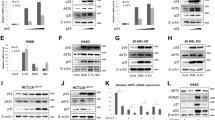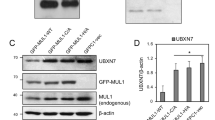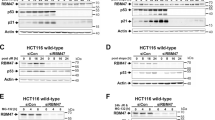Abstract
SAG (sensitive to apoptosis gene) or ROC2/RBX2 is the second family member of ROC1/RBX1, a component of SCF (Skp1, Cullin, F-box protein) and VCB (von Hippel–Lindau (VHL), Cullin and Elongin B/C) E3 ubiquitin ligases. SAG protected cells from hypoxia-induced apoptosis when overexpressed. We report here that SAG was subjected to hypoxia induction at the levels of mRNA and protein. Hypoxia induction of SAG was largely HIF-1α dependent. A consensus HIF-1-binding site, GCGTG was identified in the first intron of the SAG gene. In response to hypoxia, HIF-1 bound to this site and transactivated SAG expression. SAG transactivation required both the intact binding site in cis and HIF-1α in trans. On the other hand, like its family member, ROC1, SAG promoted VHL-mediated HIF-1α ubiquitination and degradation, which was significantly inhibited upon small interfering RNA silencing of SAG or ROC1. Furthermore, the endogenous HIF-1α at both basal and hypoxia-induced levels was significantly increased upon SAG silencing. Finally, SAG forms in vivo complex with Cul-5 and VHL under hypoxia condition. These results suggest an HIF-1-SAG feedback loop in response to hypoxia, as follows: hypoxia induces HIF-1 to transactivate SAG. Induced SAG then promotes HIF-1α ubiquitination and degradation. This feedback loop may serve as a cellular defensive mechanism to reduce potential cytotoxic effects of prolonged HIF-1 activation under hypoxia.
This is a preview of subscription content, access via your institution
Access options
Subscribe to this journal
Receive 50 print issues and online access
$259.00 per year
only $5.18 per issue
Buy this article
- Purchase on Springer Link
- Instant access to full article PDF
Prices may be subject to local taxes which are calculated during checkout






Similar content being viewed by others
References
Chanalaris A, Sun Y, Latchman DS, Stephanou A . (2003). SAG attenuates apoptotic cell death caused by simulated ischaemia/reoxygenation in rat cardiomyocytes. J Mol Cell Cardiol 35: 257–264.
Corn PG, McDonald III ER, Herman JG, El-Deiry WS . (2003). Tat-binding protein-1, a component of the 26S proteasome, contributes to the E3 ubiquitin ligase function of the von Hippel–Lindau protein. Nat Genet 35: 229–237.
Duan H, Wang Y, Aviram M, Swaroop M, Loo JA, Bian J et al. (1999). SAG, a novel zinc RING finger protein that protects cells from apoptosis induced by redox agents. Mol Cell Biol 19: 3145–3155.
Feldser D, Agani F, Iyer NV, Pak B, Ferreira G, Semenza GL . (1999). Reciprocal positive regulation of hypoxia-inducible factor 1alpha and insulin-like growth factor 2. Cancer Res 59: 3915–3918.
Forsythe JA, Jiang BH, Iyer NV, Agani F, Leung SW, Koos RD et al. (1996). Activation of vascular endothelial growth factor gene transcription by hypoxia-inducible factor 1. Mol Cell Biol 16: 4604–4613.
Gu Q, Tan M, Sun Y . (2007). SAG/ROC2/Rbx2 is a novel AP-1 target that promotes c-Jun degradation and inhibits TPA induced neoplastic transformation. Cancer Res 67: 3616–3625.
Harris AL . (2002). Hypoxia—a key regulatory factor in tumour growth. Nat Rev Cancer 2: 38–47.
Ivan M, Kondo K, Yang H, Kim W, Valiando J, Ohh M et al. (2001). HIFalpha targeted for VHL-mediated destruction by proline hydroxylation: implications for O2 sensing. Science 292: 464–468.
Jaakkola P, Mole DR, Tian YM, Wilson MI, Gielbert J, Gaskell SJ et al. (2001). Targeting of HIF-alpha to the von Hippel–Lindau ubiquitylation complex by O2-regulated prolyl hydroxylation. Science 292: 468–472.
Kamura T, Conrad MN, Yan Q, Conaway RC, Conaway JW . (1999a). The Rbx1 subunit of SCF and VHL E3 ubiquitin ligase activates Rub1 modification of cullins Cdc53 and Cul2. Genes Dev 13: 2928–2933.
Kamura T, Koepp DM, Conrad MN, Skowyra D, Moreland RJ, Iliopoulos O et al. (1999b). Rbx1, a component of the VHL tumor suppressor complex and SCF ubiquitin ligase. Science 284: 657–661.
Kamura T, Maenaka K, Kotoshiba S, Matsumoto M, Kohda D, Conaway RC et al. (2004). VHL-box and SOCS-box domains determine binding specificity for Cul2-Rbx1 and Cul5-Rbx2 modules of ubiquitin ligases. Genes Dev 18: 3055–3065.
Kamura T, Sato S, Iwai K, Czyzyk-Krzeska M, Conaway RC, Conaway JW . (2000). Activation of HIF1alpha ubiquitination by a reconstituted von Hippel–Lindau (VHL) tumor suppressor complex. Proc Natl Acad Sci USA 97: 10430–10435.
Kim SY, Lee JH, Yang ES, Kil IS, Bae YS . (2003). Human sensitive to apoptosis gene protein inhibits peroxynitrite-induced DNA damage. Biochem Biophys Res Commun 301: 671–674.
Lando D, Peet DJ, Whelan DA, Gorman JJ, Whitelaw ML . (2002). Asparagine hydroxylation of the HIF transactivation domain a hypoxic switch. Science 295: 858–861.
Maxwell PH, Wiesener MS, Chang GW, Clifford SC, Vaux EC, Cockman ME et al. (1999). The tumour suppressor protein VHL targets hypoxia-inducible factors for oxygen-dependent proteolysis. Nature 399: 271–275.
Ohta T, Michel JJ, Schottelius AJ, Xiong Y . (1999). ROC1, a homolog of APC11, represents a family of cullin partners with an associated ubiquitin ligase activity. Mol Cell 3: 535–541.
Pugh CW, Ratcliffe PJ . (2003). The von Hippel–Lindau tumor suppressor, hypoxia-inducible factor-1 (HIF-1) degradation, and cancer pathogenesis. Semin Cancer Biol 13: 83–89.
Sun Y . (2006). p53 and its downstream proteins as molecular targets of cancer. Mol Carcinog 45: 409–415.
Sun Y, Tan M, Duan H, Swaroop M . (2001). SAG/ROC/Rbx/Hrt, a zinc RING finger gene family: molecular cloning, biochemical properties, and biological functions. Antioxid Redox Signal 3: 635–650.
Swaroop M, Bian J, Aviram M, Duan H, Bisgaier CL, Loo JA et al. (1999). Expression, purification, and biochemical characterization of SAG, a RING finger redox sensitive protein. Free Radicals Biol Med 27: 193–202.
Tazuke SI, Mazure NM, Sugawara J, Carland G, Faessen GH, Suen LF et al. (1998). Hypoxia stimulates insulin-like growth factor binding protein 1 (IGFBP-1) gene expression in HepG2 cells: a possible model for IGFBP-1 expression in fetal hypoxia. Proc Natl Acad Sci USA 95: 10188–10193.
Wang GL, Jiang BH, Rue EA, Semenza GL . (1995). Hypoxia-inducible factor 1 is a basic-helix-loop-helix-PAS heterodimer regulated by cellular O2 tension. Proc Natl Acad Sci USA 92: 5510–5514.
Wu X, Bayle JH, Olson D, Levine AJ . (1993). The p53-mdm-2 autoregulatory feedback loop. Genes Dev 7: 1126–1132.
Yang GY, Pang L, Ge HL, Tan M, Ye W, Liu XH et al. (2001). Attenuation of ischemia-induced mouse brain injury by SAG, a redox-inducible antioxidant protein. J Cereb Blood Flow Metab 21: 722–733.
Acknowledgements
We thank Dr Wafik El-Deiry at the University of Pennsylvania for plasmids expressing HIF-1α, VHL and VHL mutant (VHL-Y98L), Dr Bing-Hua Jiang at West Virginia University for VEGF-luciferase reporter construct. This work is supported by the NCI grants (CA111554, CA116982 and CA118762) to YS.
Author information
Authors and Affiliations
Corresponding author
Rights and permissions
About this article
Cite this article
Tan, M., Gu, Q., He, H. et al. SAG/ROC2/RBX2 is a HIF-1 target gene that promotes HIF-1α ubiquitination and degradation. Oncogene 27, 1404–1411 (2008). https://doi.org/10.1038/sj.onc.1210780
Received:
Revised:
Accepted:
Published:
Issue Date:
DOI: https://doi.org/10.1038/sj.onc.1210780
Keywords
This article is cited by
-
RBCK1 regulates the progression of ER-positive breast cancer through the HIF1α signaling
Cell Death & Disease (2022)
-
Hypoxia-sensitive long noncoding RNA CASC15 promotes lung tumorigenesis by regulating the SOX4/β-catenin axis
Journal of Experimental & Clinical Cancer Research (2021)
-
The role of SCF ubiquitin-ligase complex at the beginning of life
Reproductive Biology and Endocrinology (2019)
-
RNF7 knockdown inhibits prostate cancer tumorigenesis by inactivation of ERK1/2 pathway
Scientific Reports (2017)
-
Depletion of SAG/RBX2 E3 ubiquitin ligase suppresses prostate tumorigenesis via inactivation of the PI3K/AKT/mTOR axis
Molecular Cancer (2016)



